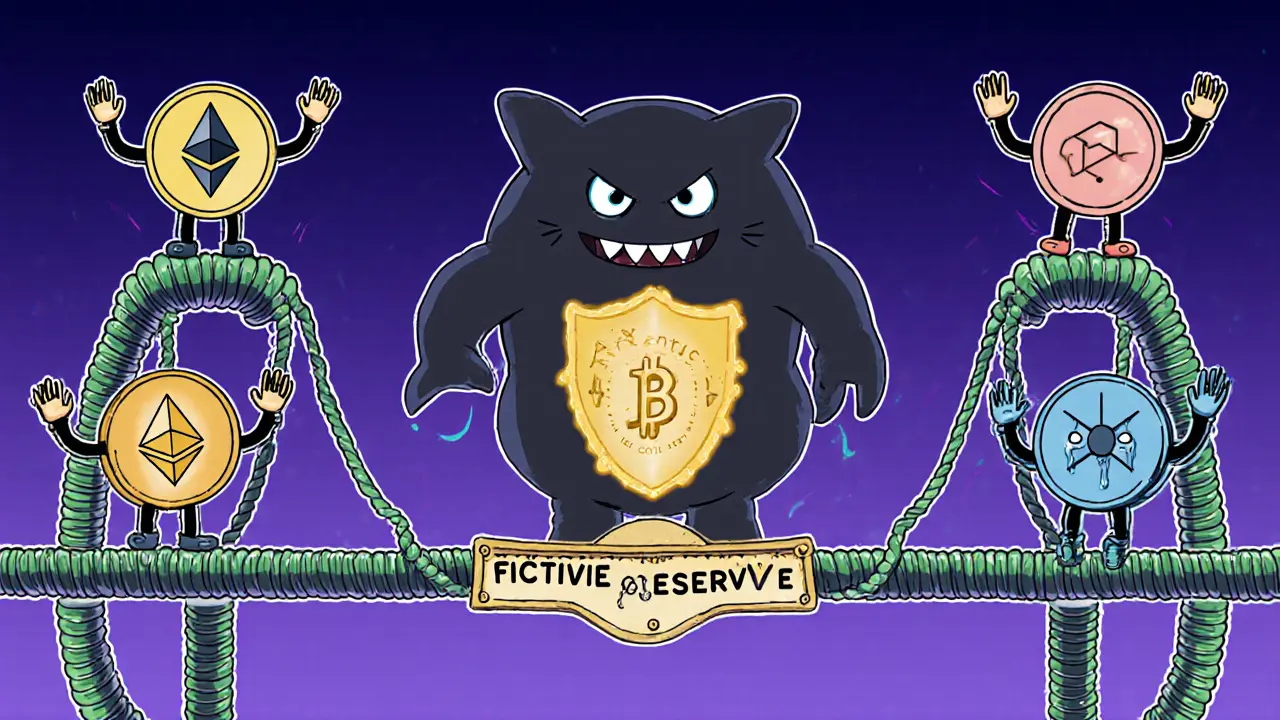Impermanent Loss Calculator
How SmarDex Reduces Impermanent Loss
SmarDex uses its proprietary fictive reserve system to offset impermanent loss. Unlike traditional DEXs (like Uniswap), which show real losses during price swings, SmarDex calculates virtual reserves to provide compensation. This often turns potential losses into gains for liquidity providers.
Results
What This Means
How SmarDex works: SmarDex's fictive reserve algorithm detects price changes and creates virtual reserves to compensate liquidity providers. This often turns potential losses into gains, as shown above.
SmarDex (SDEX) isn’t just another crypto coin. It’s the native token of a decentralized exchange built to fix one of the biggest headaches in DeFi: impermanent loss. If you’ve ever provided liquidity on Uniswap or PancakeSwap and watched your returns shrink during a price swing, SmarDex is trying to solve that problem - and it’s doing it with a system called the fictive reserve.
What Exactly Is SmarDex?
SmarDex is a decentralized exchange (DEX) that lets you trade crypto directly from your wallet, without a middleman. It launched in 2023 and runs on EVM-compatible blockchains like Ethereum, BNB Chain, Polygon, Arbitrum, and Base. That means you can swap tokens across five major networks without switching wallets or bridges. Unlike traditional DEXs that use a simple constant product formula (like x*y=k), SmarDex uses a proprietary algorithm called the fictive reserve. This system doesn’t just track real token balances - it creates a virtual reserve that adjusts dynamically during price movements. The goal? Turn what’s normally a loss for liquidity providers into a potential gain.The SDEX Token: How It Works
The SDEX token is the backbone of the platform. It’s an ERC-20 token with a fixed total supply of 10 billion. As of late 2023, around 9.2 billion were in circulation. That leaves roughly 800 million tokens reserved for future distribution, team incentives, and community programs. Here’s how SDEX is used:- Trading fees: You pay in SDEX to swap tokens, but fees are lower than most DEXs - as low as 0.02% for some users.
- Liquidity provision: When you add funds to a liquidity pool, you earn SDEX rewards.
- Staking: Lock up SDEX to earn more SDEX, plus a share of trading fees.
- Governance: Future updates may let SDEX holders vote on protocol changes.
How SmarDex Solves Impermanent Loss
Impermanent loss happens when the price of two tokens in a liquidity pool moves apart. Say you put in 50% ETH and 50% USDT. If ETH spikes, you end up with less value than if you’d just held the tokens. On Uniswap, this loss is real. On SmarDex, it’s not. The fictive reserve algorithm constantly recalibrates prices to compensate liquidity providers. Instead of losing money when volatility hits, you might actually earn more - hence the term “impermanent gains.” This isn’t magic. It’s math. The system tracks price deviations and uses a buffer of virtual reserves to offset losses. Think of it like an insurance layer built into the exchange. Early data shows it works in test environments, but real-world performance during extreme market crashes is still being watched.
Trading Fees: Cheaper Than Most DEXs
Most decentralized exchanges charge 0.3% per trade. SmarDex cuts that in half - to 0.15% - and goes even lower for users who hold or stake SDEX:- Standard traders: 0.07%
- Liquidity providers: 0.05%
- Stakers and power users: 0.02%
How Does SmarDex Compare to Uniswap and PancakeSwap?
Here’s a quick breakdown:| Feature | SmarDex (SDEX) | Uniswap (UNI) | PancakeSwap (CAKE) |
|---|---|---|---|
| Core Innovation | Fictive reserve (impermanent gains) | Standard AMM (x*y=k) | Standard AMM + yield farming |
| Trading Fees | 0.02%-0.07% | 0.3% | 0.2% |
| Blockchains Supported | Ethereum, BNB Chain, Polygon, Arbitrum, Base | Ethereum only | BNB Chain only |
| Market Cap (Nov 2023) | $28.3M | $1.1B | $720M |
| 24H Volume | $585K-$722K | $2.1B+ | $480M |
| Liquidity Depth | Moderate | Very High | High |
Where to Buy SDEX
You can’t buy SDEX on Coinbase or Binance. It’s listed on mid-tier exchanges like:- MEXC
- Gate.io
- Bitrue

Is SmarDex Safe?
The platform has undergone smart contract audits by reputable firms, though the names haven’t been publicly disclosed. That’s a red flag for some - transparency matters in DeFi. User reviews on Trustpilot give SmarDex a 4.1/5 rating, with praise for its educational content and customer support. The documentation on smardex.io is rated 4.3/5 for clarity and multilingual support (12 languages). Still, no audit report = no full confidence. Always start small. Don’t lock up your life savings until you’ve tested the platform with a few hundred dollars.Who Is SmarDex For?
SmarDex isn’t for beginners who just want to buy Bitcoin. It’s for:- Traders who make frequent swaps and want lower fees
- Liquidity providers tired of impermanent loss
- DeFi users active on multiple chains (Ethereum, Polygon, etc.)
- Investors looking for yield beyond standard staking
The Bottom Line
SmarDex (SDEX) is a bold experiment in DeFi. It’s not the biggest, fastest, or most popular exchange. But it’s one of the few trying to fix a real, costly problem: impermanent loss. Its low fees, cross-chain support, and unique algorithm make it stand out. But it’s still early. The token’s price has been volatile, with a -5.83% drop over 7 days in November 2023. Market analysts are split - some call it innovative, others say it’s unproven. If you’re curious, try it with a small amount. Connect your wallet, add a little liquidity, and see how the fictive reserve works in real time. You might find it’s the missing piece in your DeFi toolkit.Is SDEX a good investment?
SDEX isn’t a guaranteed investment. It’s a utility token tied to a young DeFi protocol. Its value depends on adoption, trading volume, and whether the fictive reserve system holds up during market crashes. Right now, it’s a high-risk, high-potential play for DeFi enthusiasts - not a buy-and-hold crypto like Bitcoin.
Can I earn passive income with SDEX?
Yes. You can stake SDEX to earn more tokens, or provide liquidity to trading pairs and earn a share of trading fees. The platform offers higher rewards than many competitors, but you’re exposed to price volatility. Always check the APY before locking funds.
How do I get started with SmarDex?
First, set up a Web3 wallet like MetaMask. Buy some ETH, BNB, or USDT on a centralized exchange, then transfer it to your wallet. Go to smardex.io, connect your wallet, and start swapping or adding liquidity. You’ll need SDEX tokens to pay fees, so buy a small amount on MEXC or Gate.io first.
Is SmarDex available on mobile?
Yes. You can access SmarDex through any mobile browser using MetaMask or Trust Wallet. There’s no official app yet, but the website is fully responsive and works well on phones.
What’s the difference between SDEX and other DeFi tokens like UNI or CAKE?
UNI and CAKE are governance tokens for large, established DEXs with massive liquidity. SDEX is a utility token for a newer platform focused on solving impermanent loss. SmarDex offers lower fees and a unique risk-reward model, but it lacks the user base and trading volume of its bigger rivals.

Comments (15)
sky 168
November 23, 2025 AT 14:58
SmarDex is trying to fix impermanent loss but let’s be real - if it was that easy, Uniswap would’ve done it already.
Still, low fees are nice.
Devon Bishop
November 24, 2025 AT 03:58
i tried smardex last week after reading this post and wow the fees are insane low like 0.02% for stakers
but the interface is kinda clunky and my first swap took 3 mins to confirm on polygon
also the fictive reserve thing? idk if its magic or just fancy math but i didnt lose money on a 20% eth swing so i’m not complaining
sammy su
November 24, 2025 AT 09:44
if you’re new to defi dont touch this yet
learn how uniswap works first
then come back
also make sure you have enough gas
trust me i lost 15 bucks on a failed tx because i forgot to check my bnb balance
jack leon
November 24, 2025 AT 20:40
THIS IS THE FUTURE OF DEFI
IMPERMANENT LOSS IS A SCAM BY THE OLD GUARD
SmarDex is the phoenix rising from the ashes of Uniswap’s outdated math
they’re not just fixing a problem - they’re rewriting the rules
if you’re not in this before 2025 you’re already behind
Chris G
November 25, 2025 AT 00:31
fictive reserve is just a rebrand of dynamic slippage control used in curve finance since 2020
nothing new here just marketing fluff
also 10b supply with 9.2b circulating means massive inflation pending
Sunita Garasiya
November 25, 2025 AT 20:41
oh look another project that thinks it’s the next big thing
the only thing more fake than the fictive reserve is the 4.1 trustpilot rating
probably paid for by the dev team’s cousin’s dog
Mike Stadelmayer
November 27, 2025 AT 00:08
i’ve been dipping my toes in with 50 bucks
not gonna get rich but the experience is actually smooth
and yeah i did earn more than i lost on a volatile pair
maybe its not magic but its better than nothing
Anthony Demarco
November 27, 2025 AT 03:42
this is why america still leads in crypto innovation
china and europe are still stuck in their regulatory mud
if you’re not using smardex you’re letting the old world win
Melina Lane
November 28, 2025 AT 05:14
just tried it and it actually works
no drama no panic
the app is simple and the rewards are real
small deposit but i’m hooked
andrew casey
November 28, 2025 AT 08:50
The purported algorithmic innovation of SmarDex, while superficially compelling, lacks the rigorous peer-reviewed validation necessary to substantiate its claims within the broader DeFi ecosystem.
One must question whether the fictive reserve constitutes a genuine economic mechanism or merely a semantic obfuscation of existing AMM dynamics.
Kaitlyn Boone
November 28, 2025 AT 12:45
audit not public? lol
you think i’m gonna lock my cash into a project that won’t even name the auditor?
they’re hiding something
probably a backdoor or a rug pull waiting to happen
Jack Richter
November 30, 2025 AT 01:15
eh i’ll stick with uniswap
less thinking required
Khalil Nooh
December 1, 2025 AT 05:09
IF YOU’RE STILL USING UNISWAP YOU’RE LEAVING MONEY ON THE TABLE
SMARDEX ISN’T JUST BETTER - IT’S A REVOLUTION
THE FEES ARE LOWER, THE CHAINS ARE BROADER, AND THE IMPERMANENT LOSS FIX? THAT’S NOT A FEATURE - THAT’S A GAME CHANGER
YOU DON’T NEED TO BE A GENIUS TO SEE THIS
YOU JUST NEED TO BE BRAVE ENOUGH TO TRY
Lynn S
December 1, 2025 AT 22:12
The lack of transparency regarding audit firms is a glaring red flag.
Furthermore, the tokenomics structure suggests a deliberate concentration of supply in early adopters, which is inherently manipulative.
One cannot ethically endorse a protocol that prioritizes speculative incentive over structural integrity.
sky 168
December 2, 2025 AT 01:57
devon said the interface is clunky
yeah it is
but the fee savings made up for it
just use mobile browser not desktop